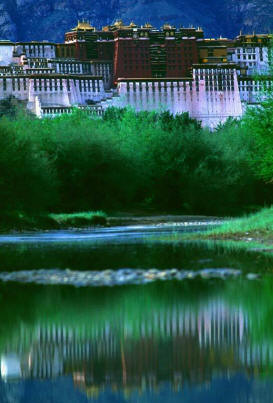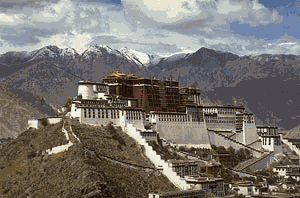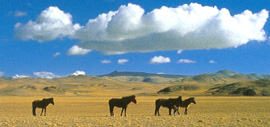

The International Forum
Travels
to Tibet
May 20-27, 2006
An unusual social order on the roof of the world - Tibet dazzles both the eye and the mind with its otherworldly natural environment, mountainous landscapes, sprawling Buddhist temples and ethnically diverse population.
Tibet is politically an integral part of the People's Republic of China, yet it shares a closer cultural bond with the peoples of the Himalayas. And while Chinese engineers are now building the world's highest-altitude railroad link on permafrost, between Tibet and western China, Tibet is bound to retain its separateness and uniqueness, the very qualities that made it the setting for Shangri-la, both real and fictional.
Through close encounters with Tibetan people, The International Forum engages in actively exploring how they live and work in their social environment – including the initiatives that are involving them with those in other parts of the world in using their talents and skills. Tibet’s present and future are considered with an understanding of its culture – drawing on its history, art, religion, and a society and economy in this remote part of the world.
The program engages participants in encounters such as:
Meeting young entrepreneurs and those helping to develop small business enterprises in Tibet to understand the challenges they face and the progress they have made
Meeting and speaking with people involved in and leading change in Tibet through education, health and business
Exploring the principal temples and bazaars of Lhasa in the company of monks and pilgrims – to understand their ways, the traditions they are following and the flow of produce that contributes to their economy
Visiting the vast Potala palace - Tibet's "forbidden city" and the finest example of religious architecture in Tibet - to consider the spiritual history of this remote society
This program is led by Peggy Day who has worked in the Himalaya for over 20 years. In addition to operating treks in Tibet, Bhutan and Mongolia, her involvement in development projects with the local people have given her a deep appreciation of Himalayan cultures. Her friends and mentors include Her Majesty Ashi Tsering Pem, Queen of Bhutan, Sir Edmund Hillary, and many political and religious leaders throughout the Himalaya. She is responsible for the construction and maintenance of a home for 17 children in Tibet.

ITINERARY
Throughout the program, in addition to encountering the spiritual and natural beauty of Tibet, participants meet with local leaders and those involved in small enterprises, orphanages, schools and healthcare.
May 20, Saturday: Depart Wuhan
for
May 21, Sunday:
Depart

You are now at 12,000 feet so a light lunch and time to rest will help your body adjust. Later in the afternoon, those who have acclimatized to the elevation can join the pilgrims on their circumambulation path around the Barkor.
Take some time to enjoy the
visual richness of the area and explore some of the stalls and shops that line
the path. Enter the
 In
the evening, meet with representatives from Terma Foundation, a small
humanitarian organization whose creative programs combine indigenous and western
knowledge to confront the health crisis now affecting 6 million Tibetans within
In
the evening, meet with representatives from Terma Foundation, a small
humanitarian organization whose creative programs combine indigenous and western
knowledge to confront the health crisis now affecting 6 million Tibetans within
May 22, Monday:
The small size and simple
structure of the industrial sector in
After lunch, meet the
director of the Tibet Development Fund, the non-government organization
of Tibetans providing aid with the help of the international community.
Visit the children of Chushul Home, an orphanage built and
maintained under the direction of The Development Fund.
We speak with the members of the community whose vision and commitment
were vital to the creation of this unique project.
Discuss possible ways to use available tools and resources to reach
future goals.
 May
23, Tuesday:
May
23, Tuesday:
On our way back to
In the late afternoon, a barbecue and personal exchange with Tibetan government officials who will both answer and raise questions about Tibet’s status as an autonomous region.
May 24, Wednesday:

An afternoon drive in the
countryside will give you an opportunity to see both the daily life and
spiritual rituals in the traditional Buddhist community. We’ll look at the
role religion still plays in daily life and its far-reaching effects. See how
the village life of nomadic peasants and yak herders has a relevance far beyond
the Tibetan Plateau. As guardians of the headwaters of seven major Asian rivers,
their environmental, educational and economic status directly affects a quarter
of the world’s population downstream. Meet village leaders to discuss the
challenge of keeping a functional coexistence of economic needs and the fragile
ecosystem of the Tibetan Plateau.
Our journey continues to
Ganden Monastery, once the largest monastery of the Gelugpa sect of Tibetan
Buddhism. Although it was literally leveled by explosives, it is still
considered a major pilgrimage center to Tibetans and is slowly being restored by
local, volunteer efforts. Look into
an inner realm of spirituality as monks perform a powerful tantric ceremony.
Afterwards, a discussion with senior monks will provide insights into
their unyielding faith in the cycle of life: birth, life, death, and rebirth and
the role it plays in daily life.
Return to
May 25, Thursday:
SAMYE MONASTERY/TSEDANG In the
morning, drive out to a ferry landing to join the local pilgrims on their way to
Samye Monastery. The adventure
begins by crossing the
Temples
and chortens (reliquaries and symbols of Buddha’s mind) are configured around
the main monastery as a geographic mandala.
Walk in this three-dimensional model of the Buddhist universe, guided by
local artists, in order to understand the symbolism found in the elaborate
artwork and ritual objects. Look at
the traditional monastic education and it’s relevance today in the community.
Given the close interrelationship with religion and everyday life here,
meet monks working as teachers, doctors, administrators, and priests.
Return to the boat and cross the river to where we will be met and driven
to the nearby town of
 In
Tsedang, visit a Chinese model school that teaches both Chinese and Tibetan
languages in addition to the standard Chinese curriculum. Meet with headmaster
and instructors to identify advantages and disadvantages of the students
potential success.
In
Tsedang, visit a Chinese model school that teaches both Chinese and Tibetan
languages in addition to the standard Chinese curriculum. Meet with headmaster
and instructors to identify advantages and disadvantages of the students
potential success.
Finish the day by joining
locals in their evening walk of prayer around the Sang Ngag Zimche nunnery, the
most religiously active place in Tsedang before returning to hotel.
May 26, Friday: Chengdu and beyond. Depart for Gongkar airport at 6am, arriving by 8am for 9:30am flight to Chengdu, and connect to Shanghai/Beijing/Hong Kong. End of program.
For a complete list of suggested Readings - click here
